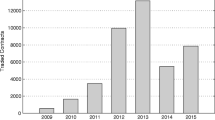Abstract
The well-known binomial and trinomial tree models for option pricing are examined from the point of view of numerical efficiency. Common lattices use a large part of time resources for calculations which are almost irrelevant for the solution. To avoid this waste of resources, the tree is reduced to a “lean” form which yields the same order of convergence, but with a reduction of numerical effort. In numerical tests it is shown that the proposed method leads to a significant improvement in real calculation time without loss of accuracy for a broad class of derivatives.
Similar content being viewed by others
References
Abramowitz, M. and I.A. Segun. (1964). Handbook of Mathematical Functions. New York: Dover.
Boyle, P.P. (1986). “Option Valuation Using a Three-Jump Process,” International Options Journal 3, 7–12.
Boyle, P.P. (1988). “A Lattice Framework for Option Pricing with Two State Variables,” The Journal of Financial and Quantitative Analysis 23, 1–12.
Boyle, P.P. and S.H. Lau. (1994). “Bumping up against the Barrier with the Binomial Method,” The Journal of Derivatives 1,Summer, 6–14.
Breen, R. (1991). “The Accelerated Binomial Option Pricing Model,” The Journal of Financial and Quantitative Analysis 26, 153–164.
Broadie, M. and J. Detemple. (1995). “American Capped Call Options on Dividend-Paying Assets,” The Review of Financial Studies 8, 161–191.
Broadie, M. and J. Detemple. (1996). “American Option Valuation: New Bounds, Approximations, and a Comparison of Existing Methods,” The Review of Financial Studies 9, 1211–1250.
Chen, R.-R. and T.T. Yang. (1999). “A Universal Lattice,” Review of Derivatives Research 3, 115–133.
Cho, H.Y. and K.W. Lee. (1995). “An Extension of the Three-Jump Process for Contingent Claim Valuation,” The Journal of Derivatives 3,Fall, 102–108.
Cox, J.C., S.A. Ross, and M. Rubinstein. (1979). “Option Pricing: A Simplified Approach,” Journal of Financial Economics 7, 229–263.
Curran, M. (1995). “Accelerating American Option Pricing in Lattices,” The Journal of Derivatives 3,Winter, 8–18.
Figlewski, S. and B. Gao. (1999). “The Adaptive Mesh Model: A New Approach to Efficient Option Pricing,” Journal of Financial Economics 53, 313–351.
Geske, R. and H.E. Johnson. (1984). “The American Put Option Valued Analytically,” The Journal of Finance 39, 1511–1524.
Hull, J.C. (2003). Options, Futures, and Other Derivatives, 5th ed. Upper Saddle River: Prentice Hall.
Hull, J.C. and A. White. (1988). “The Use of the Control Variate Technique in Option Pricing,” The Journal of Financial and Quantitative Analysis 23, 237–251.
Jarrow, R. and A. Rudd. (1983). Option Pricing. Homewood, IL: Dow Jones-Irwin.
Karatzas, I. and S.E. Shreve. (1991). Brownian Motion and Stochastic Calculus, 2nd ed. New York: Springer.
Leisen, D. (1998). “Pricing the American Put Option: A Detailed Convergence Analysis for Binomial Models,” Journal of Economic Dynamics and Control 22, 1419–1444.
Leisen, D. and M. Reimer. (1996). “Binomial Models for Option Pricing—Examining and Improving Convergence,” Applied Mathematical Finance 3, 319–346.
Ritchken, P. (1995). “On Pricing Barrier Options,” The Journal of Derivatives 3,Winter, 19–28.
Stulz, R.M. (1982). “Options on the Minimum or the Maximum of Two Risky Assets,” Journal of Financial Economics 10, 161–185.
Author information
Authors and Affiliations
Corresponding author
Rights and permissions
About this article
Cite this article
Baule, R., Wilkens, M. Lean Trees—A General Approach for Improving Performance of Lattice Models for Option Pricing. Review of Derivatives Research 7, 53–72 (2004). https://doi.org/10.1023/B:REDR.0000017028.57712.19
Issue Date:
DOI: https://doi.org/10.1023/B:REDR.0000017028.57712.19




